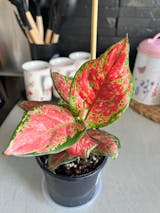How and when to repot your new plant
It can be tempting to repot a plant as soon as you bring it home. After all, you want to make sure you're doing all you can to make it as comfortable and healthy as possible. However, too much of a good thing can be.... too much! We pride ourselves on how we pack our plants for the mail here at Uprooted, taking the upmost care to perfectly package our plants so they are secure, snug, healthy and arrive intact, thanks to our specialised packaging solution. And all of our plants (except for tube stock) are sent in their own nursery pot.
So we recommend that you hold off repotting for at least a few weeks after your new plant arrives. The reasoning behind this is simple. A plant has a lot to acclimate to when it's brought into a new home. Our homes are dark, dry caves by comparison to the humid, bright nurseries they previously lived in. So during the first few weeks of adjusting, they may experience some stress, and the process of having their roots dug up, touched, exposed to light and moved may very well add to that. So giving the plant a chance to adjust first helps.

After a few weeks of acclimation, you may then choose to repot your new plant. However, just to note, it's still not necessary to do at that stage - you can leave a plant in its nursery pot for months so long as it's not outgrowing its pot or its roots aren't escaping out the base or top. Most gardeners agree that plants should be repotted every 12 to 18 months in order to receive the refreshed nutrients that come in a new batch of soil.
Once you've decided it's time to repot, here are some simple steps to follow:
1. Remove the plant from its potTo do this, turn the pot on its side on the ground or a smooth surface. If it's plastic, you can squeeze the outside at different points with your hands to encourage the plant out. Otherwise you can use your hands to dig out a bit of soil to loosen up the potting mix. You may want to hold it gently by its middle stem/s and ever so lightly tug it, but avoid using too much force. No matter your method, make sure you slowly and gently ease the plant out so that its roots, stems and leaves all remain in tact.
2. Lay the plant down on its side and loosen its rootsOnce you've wiggled the plant out, you have a chance to take a look at its roots, which you may decide to give a very light massage to loosen them up a little. Depending on how the plant has grown, it may have formed a tight root ball in the centre, which you can tease out a little. You may wish to do this on a plastic bag or similar to make disposing of the old soil easy.
3. Remove the old potting mixPotting mix has a life span, as it contains nutrients that are slowly absorbed by a plant over time. When you repot a plant, you are giving it a brand new dose of nutrients, therefore the old soil is no longer needed. So after you've removed your plant from its old soil, you can dispose of it or add it to your compost.
4. Change/update the pot size
If the plant has outgrown the pot, choose a pot that is one or two sizes larger than its current pot. If you're just refreshing the soil, you can use the same nursery pot if you so choose, or pot it into something else - the choice is yours! We recommend using pots with drainage holes to avoid root rot, by the way! Check out our range of specialised growers pots, which come in a range of sizes and colours, and are carefully selected to suit the range of tropical, rare and unusual plants we stock.

5. Add new soil
Sprinkle some new potting mix at the base of the pot you are replanting into.
6. Add the plant and pack potting mix in
Add the plant (roots first) into the pot on top of the layer of soil you just added, and then fill the sides with potting mix until the pot is full. Pack it in lightly to ensure the mix has airflow so water can drain and roots can grow easily.
7. Water it in
Start with a little sprinkle of water on the surface, wait a few seconds, and then deeply water the plant until water runs out the base of the pot or planter. This technique of adding a tiny amount of water, and then waiting, will avoid water pooling and running over the edges, and allows you to water the entirety of the soil, avoiding dry patches.
And that's it!
A lot of online general gardening guides will tell you to avoid repotting at certain times of year, e.g. Winter, however in the case of indoor plants, if they're living inside within a temperature range of 15 to 25 Celcius (which most homes naturally achieve), feel free to repot at any time of the year. Any plants you have living outside, for example on your balcony, verandah or around your garden, are best repotted in Spring/Summer.
Need some help?
If you have any questions about repotting or which of our grower pots is best suited for your plants, please get in touch via email at hello@uprooted.com.au or DM us on Instagram or Facebook.







